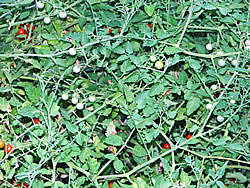Search
For The Answer
Click here to access our database of
Plant Answers
Search
For The Picture
Click here to access the Google database of plants
and insects
Information
Index
Alphabetical Listing of Topics, Recommendations
and Plants
Milberger's Nursery and Landscaping
3920 North Loop 1604 E.
San Antonio, TX 78247
210.497.3760
nursery@milbergersa.com
Open 9 to 6 Mon. through Sat.
and 10 to 5 on Sun.

Three exits east of 281, inside of 1604
Next to the Diamond Shamrock station
Please click map for more detailed map and driving directions.
Red Currant Tomato (Lycopersicon pimpinellifolium) / AKA Spoon Tomato From Totally Tomatoes: (65 days). Actually a different plant species, Lycopersicon pimpinellifolium, than garden tomatoes, but capable of crossing with them. Pea-sized fruits - just 1/4" in diameter - possess a crunchy, fruity flavor that is ideal for salads and snacks. More vigorous vines than the shattering-type, 15 to 20 fruits are produced per branching cluster, with loads of flowers putting on a show in late June. Indeterminate. +++++++++++++++++++++++++++++++++++++++++++++++++++++++++++++++ From Southern Exposure Seed Exchange: (Lycopersicon pimpinellifolium) Currant tomatoes are essentially wild tomatoes, little changed by domestication. Vines are long indeterminate with an open growth habit and generally good disease resistance. Fruits are the size of a berry, 1/2" to 3/4" in diameter. Flavor is intense, sweet and piquant. They are specially suited as salad accents and for the specialty restaurant trade. Seeds are small. ++++++++++++++++++++++++++++++++++++++++++++++++++++++++++++++
Physical Characteristics Annual growing to 1m by 0.5m . It is hardy to zone 9 and is frost tender. It is in flower from June to September, and the seeds ripen from August to October. The flowers are hermaphrodite (have both male and female organs) and are pollinated by Insects. The plant is self-fertile. We rate it 4 out of 5 for usefulness. The plant prefers light (sandy), medium (loamy) and heavy (clay) soils and requires well-drained soil. The plant prefers acid, neutral and basic (alkaline) soils. It cannot grow in the shade. It requires moist soil.
Cultivated Beds.
Fruit; Oil. Fruit - raw, cooked or dried for later use. Sweet and delicious, it makes an excellent dessert fruit and is also used in savory dishes as a vegetable. The fruit is rather small and fiddly, about 10 - 15mm in diameter, but it is produced in quite large bunches and is well worth the effort of picking. An edible oil is obtained from the seed. The seed is small and it would be very fiddly to utilize. It is only viable to use the seed as a source of oil if large quantities of the plants are being grown for their fruits and the seed is not wanted.
Cardiac; Homeopathy; Odontalgic; Skin. The pulped fruit is an extremely beneficial skin-wash for people with oily skin. Sliced fruits are a quick and easy first aid treatment for burns, scalds and sunburn. A decoction of the root is ingested in the treatment of toothache. The skin of tomato fruits is a good source of lycopine, a substance that has been shown to protect people from heart attacks. It seems to be more effective when it is cooked and so can be obtained from food products such as tomato ketchup and tinned tomatoes. A homeopathic remedy is made from the plant. It is used in the treatment of rheumatism and severe headaches.
Oil; Repellent. The strong aroma of this plant is said to repel insects from nearby plants. A semi-drying oil is obtained from the seed. Used in making soap.
Requires a rich well-drained soil in a sunny position. Plants are not frost-hardy. They can be grown outdoors in Britain as a spring-sown annual started off under glass in the spring. In cool wet summers the total yields are likely to be low. A form of tomato with a small but delicious tasting fruit, it is often treated as a separate species. There are some named varieties.
Seed - sow early spring in a warm greenhouse. Germination is usually quick and good. Pot up the seedlings into individual pots of fairly rich compost as soon as the first true leaf appears and plant them out after the last expected frosts. Seed can also be sown in situ under a cloche at the end of April, though in a cool summer the results may be disappointing. The seedcoat may carry tomato mosaic virus. However, by sowing the seed 15mm deep the seedcoat will remain below the soil surface when the seed germinates and the disease will be inactivated. |
||||






